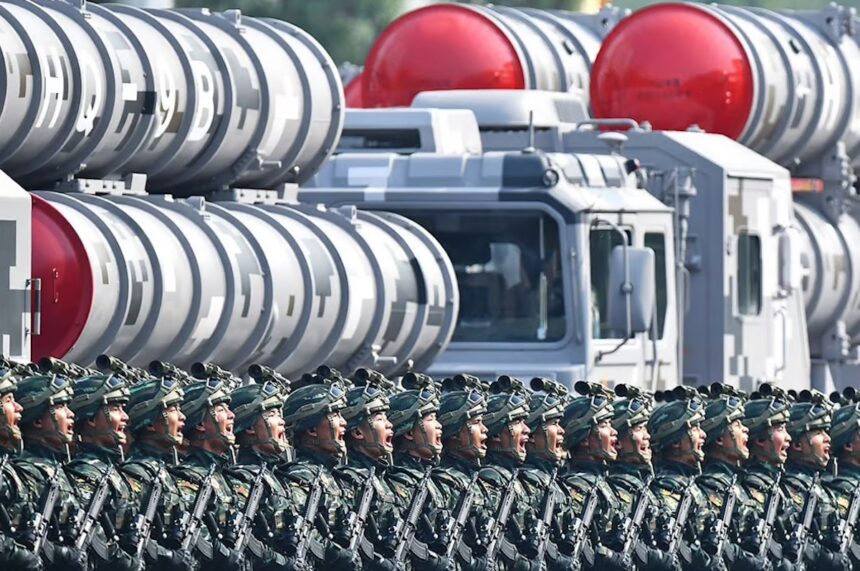Summary by Geopolist | Istanbul Center for Geopolitics:
China’s rapid nuclear development is forcing the United States to reconsider its nuclear strategy, especially in regard to potential conflicts over Taiwan.
A report by the Center for a New American Security (CNAS) highlights that China’s nuclear modernization in the Indo-Pacific region increases the likelihood of non-strategic nuclear weapon use, a significant shift from the Cold War-era deterrence approach. The US is currently not well-prepared to manage this new reality due to outdated doctrines and capabilities.
The report suggests that China could target US allies in the region, such as Japan and Australia, potentially threatening the US extended deterrence. Therefore, the report recommends improving the US nuclear strategy, enhancing dialogue with China, and collaborating with allies to strengthen resilience against Chinese nuclear coercion.
Despite significant downsizing and cost overruns, the US is engaged in a comprehensive nuclear modernization program. The US maintains the world’s second-largest nuclear arsenal with 5,044 warheads, though only around 1,770 are currently deployed. China’s nuclear arsenal, currently at approximately 500 warheads, is projected to reach 1,000 by 2030. This expansion is part of China’s broader strategy to establish itself as a global military power by 2035, challenging the existing global strategic balance and potentially moving away from its “no first use” policy.
There are concerns that China may lower the threshold for nuclear use during a Taiwan conflict, using nuclear weapons to deter US and allied intervention.
Read more below.
US ill-prepared for a nuclear showdown with China
This month, the Center for a New American Security (CNAS) released a report saying that the evolving nuclear dynamics in the Indo-Pacific region, driven by China’s rapid nuclear modernization, increase the likelihood of nonstrategic nuclear weapons use in such a conflict.
The report highlights that once nuclear escalation begins, reciprocal tactical nuclear exchanges may occur without necessarily leading to general nuclear war, a significant departure from Cold War-era deterrence models.
The report’s findings indicate that the US is ill-equipped to manage this new nuclear reality, including regarding doctrine, capabilities and concepts. The study also emphasizes the strategic importance and vulnerability of US allies in the region, such as Japan and Australia, suggesting that China could target these alliances to undermine US extended deterrence.
The CNAS report recommends that the US improve its nuclear fluency among senior leaders, enhance dialogue with China and develop new operational concepts and capabilities to better integrate conventional and nuclear strategies. It also calls for detailed planning with regional allies to bolster resilience against potential Chinese nuclear coercion.
The report also underscores the need for the US to adapt its strategic thinking and capabilities to address the challenges posed by China’s nuclear expansion in the Indo-Pacific theater.
The US maintains the world’s second-largest nuclear arsenal with 5,044 warheads and is undergoing a comprehensive modernization program despite substantial downsizing and cost overruns.
In a May 2024 article for the Bulletin of Atomic Scientists, Hans Kristensen and other writers mention that the US currently has around 3,708 nuclear warheads, with approximately 1,770 deployed and 1,938 in reserve. 1,336 retired warheads await dismantlement while a modernization program is underway to upgrade all nuclear delivery systems.
Kristensen and others note that the US is implementing a thorough nuclear modernization program to replace all existing nuclear delivery systems with updated versions over the next several decades.
The program will affect warheads stored in 24 locations across 11 US states and five European countries, with the largest stockpile located in New Mexico and Washington.
The Bulletin of Atomic Scientists report says the US seems to be abiding by New START treaty limits despite Russia’s suspension, with 1,419 deployed warheads reported as of March 2023.
The 2022 Nuclear Posture Review maintains the right to deploy nuclear weapons under extreme circumstances and continues with US modernization plans such as retiring the B83-1 gravity bomb and canceling the sea-launched cruise missile (SLCM).
However, while Kristensen and others note that the Minuteman III ICBMs will be replaced by the new LGM-35 Sentinel missiles, with a deployment schedule and modernization efforts extending beyond 2039, the project faces significant cost overruns.
China is building new nuclear warheads at a rapid-fire pace while fielding new delivery systems, possibly lowering nuclear use thresholds and widening its nuclear options during a Taiwan conflict.
In a separate January 2024 report for the Bulletin of Atomic Scientists, Kristensen and others mention that China’s nuclear arsenal has expanded significantly, marking a pivotal shift in global strategic dynamics.
Kristensen and others say that China now possesses approximately 500 nuclear warheads, with projections suggesting this could increase to 1,000 by 2030. They note this rapid expansion is part of a broader modernization campaign that includes the development of new missile silos, submarine-launched ballistic missiles (SLBMs) and air-launched ballistic missiles (ALBMs).
Kristensen and others point out that China’s growing nuclear capabilities are a response to perceived threats from the US and its allies, and part of its broader goal to establish itself as a global military power by 2035.
Most tellingly, they note that China’s advancements, particularly in missile technology and warhead production, challenge the long-standing balance of power and raise concerns about potential shifts in nuclear strategy, including the possibility of a shift away from its traditional “no first use” policy.
They note that China’s expanding nuclear arsenal comes amid heightened tensions in the Indo-Pacific region, where China’s growing assertiveness has led to increased scrutiny from the international community, particularly the US, which views China’s nuclear ambitions as a significant strategic threat.
Gregory Weaver says in a November 2023 Atlantic Council article that China could use nuclear weapons in a Taiwan conflict to deter US and allied intervention, prevent US coercion by deterring the US from using nuclear weapons against the Chinese mainland and deter the US from limited use of nuclear weapons to defend Taiwan.
On the other hand, Weaver says the US could use its nuclear weapons to deter a Chinese invasion of Taiwan, prevent China from limited nuclear weapons use on Taiwan or an attack against the US mainland, deter a Chinese non-nuclear strategic attack and deter Russian aggression while focusing on a Taiwan conflict.
While China’s nuclear arsenal is still dwarfed by the US’s, Lauren Sukin argues in an October 2023 Carnegie Endowment for International Peace article that possessing more nuclear weapons does not necessarily equate to greater security or strategic advantage.
Sukin points out that states with nuclear superiority often struggle to achieve better outcomes in conflicts because the existence of nuclear weapons creates a mutual deterrence dynamic. She says that the presence of nuclear weapons, even in smaller quantities, is sufficient to deter aggression, making it difficult for a state with superior nuclear capabilities to leverage its advantage.
She adds that the fear of mutual destruction means that even nuclear-superior states cannot easily coerce their adversaries, as both sides recognize the catastrophic consequences of any nuclear exchange.
Sukin challenges the traditional view that expanding nuclear arsenals enhances deterrence, suggesting instead that even nuclear parity or limited arsenals can effectively prevent aggression, thus raising questions about the rationale behind nuclear arms races.
In line with Sukin’s ideas, Frank Miller argues in an April 2024 article for The Economist that the US must reassess its nuclear strategy. Miller notes the current geopolitical landscape, marked by Russia’s aggression in Ukraine and China’s rapid nuclear expansion, starkly contrasts with the era that birthed the New START treaty.
The New START treaty, set to expire in 2026, inadequately addresses today’s challenges, particularly Russia’s sizable shorter-range arsenal and China’s non-participation, Miller notes, emphasizing that deterrence, not parity, is critical.
He argues the US nuclear arsenal should be capable of targeting what its autocratic adversaries value most, i.e. their regimes’ bureaucratic and support structures, conventional and nuclear forces, and war-supporting industries, to prevent aggression.
He advocates for a comprehensive treaty encompassing all nuclear weapons and allowing flexibility within overall limits, ensuring that the US can effectively deter threats and maintain global stability.
Source: Asia Times







